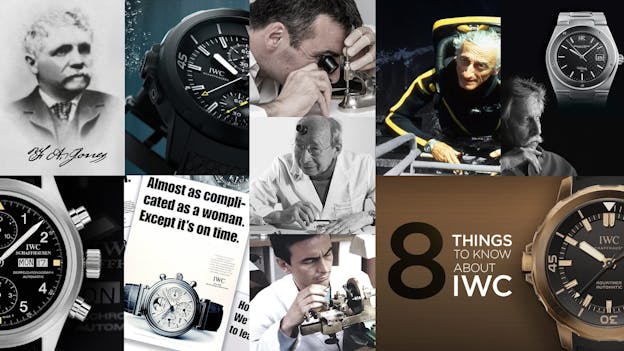8 Things to Know About IWC

There’s a lot we all know about the beloved International Watch Company. Famed for their iconic pilot’s watch collection, the longstanding brand is one of the most widely-known faces in the Richemont Group portfolio. That said, much has evolved with IWC throughout the years, leaving a trail of stories and innovations, some of which have been much less heavily reported than others.
Discover IWC
In this latest installment of “8 Things You Didn’t Know About”, we’re digging into the IWC archives for a look at some of those little tidbits both historical and modern for a deeper look at what brought the brand to where it is today.
American Connection

Of the many fun IWC factoids out there, many do not realize the brand’s creation came at the hand of an American. Florentine Ariosto Jones, a watchmaker from Boston, founded the International Watch Company in 1868 with the intent of combining the quality and skills of Swiss watchmaking with the industrialized manufacturing processes that had already taken hold stateside. By 1880 Jones’ operation was acquired by Schaffhausen-based engine manufacturer Johannes Rauschenbach-Vogel, quickly putting a close to the brand’s transatlantic affair.
Not Your Average Black Watch

Countless watch brands have a black-cased watch in their repertoire, as PVD and DLC treatments have been all the rage for a good couple of decades in the watch industry now (if not longer). Rather than following the conventional path, IWC has used an interesting and quite durable thin rubberized coating on a handful of its limited-edition Aquatimer models in recent years that provides the same matte black aesthetic as DLC. In our experience this coating has at least a similar if not better shelf life than PVD and DLC, all while giving the case a unique tactile property. As with any treatments, the right sharp gouge will breach the coating and expose the steel below, though these Aquatimers are certainly qualified for tool watch duty.
The Life Aquatic

Generally when people think of the Cousteau family and dive watches, Doxa is the first brand that comes to mind, however IWC has had significant involvement with the Cousteau Society dating back to 2004. The duo has released a significant number of limited-edition watches with partial proceeds going to support the society, as well as funneling additional funds into special projects. Among other things, IWC was a major supporter of the society’s efforts to refurbish the research vessel Calypso, upon which Cousteau spent over 40 years conducting his underwater research.
The Other Genta Icon

Gerald Genta’s most recognized work is of course the Audemars Piguet Royal Oak, though the watch industry design icon had hands in a number of other creations through the ‘70s and beyond, including the redesign of the IWC Ingenieur that arrived in 1976. Notably recognizable design cues include exposed bezel fastening screws and an integrated bracelet, and even the h-link bracelet is at least reminiscent of his design of the Nautilus for Patek Philippe that launched two years prior. Sadly the Ingenieur never saw the same fame as some of Genta’s other creations, though in trade it makes for a more approachable way to own a piece of watchmaking history.
Changing the Split-Seconds Game

While the split-seconds chronograph had been around for quite some time, for the longest time it remained a more exclusive and pricey offering from the masters of high watchmaking. Thanks to the vision of Richard Habring, IWC set out to change that, building the Doppelchrono Reference 3711. Using the workhorse Valjoux 7750 as a base, Habring’s split-seconds chronograph simplified the complex mechanism in a way that proved more durable and reliable than any past iteration. To this day it remains surprisingly approachable as well, with steel-cased variants floating around the $5,000-$6,000 mark on the secondary market.
Other Watchmaking Legends

During the late ‘80s and early ‘90s, you may be shocked to see the legendary names from complicated watchmaking that toiled away under the IWC umbrella. If you skim the list of patents held by the brand during the time, you’ll see the likes of Kurt Klaus, Richard Habring, and of course the dynamic duo of Dominique Renaud and Giulio Papi. This was an era where IWC delivered huge bang-for-buck to collectors and enthusiasts, even when it came to grand complications, and their beloved Doppel Chrono mentioned above.
Boundary Pushing Advertising—The Machismo Era

In the early 2000s, IWC decided to push an interesting marketing campaign centering around the tagline of Engineered For Men. Much akin to some of the edgy advertising from Porsche which featured statements like “Honestly now, did you spend your youth dreaming about someday owning a Nissan or Mitsubishi?”, IWC took the machismo a step further with lines like “Almost as complicated as a woman. Except it’s on time”, and “Often seen on stewardesses’ bedside tables”. Though they caused quite the stir, it was precisely this kind of boundary pushing that then-CEO George Kern was known for, and the clout surrounding the much-loved brand continued to grow into what it is today.
Also In Bronze

As popular as bronze watches have been in recent years, The IWC Aquatimer Automatic Edition “Forum Collectors Watch” seems to garner less attention than other bronze models out there like the Zenith Type 20 or the Oris Carl Brashear. The matte black dial and matching gilt indices and hands on the Aquatimer give the watch a look that’s quite distinct from the rest of the collection, and the fact that it was produced in a small 250-piece limited edition makes its lack of popularity all the more confounding.
Author Justin Mastine-Frost
The 1916 Company is an Authorized IWC Retailer.

